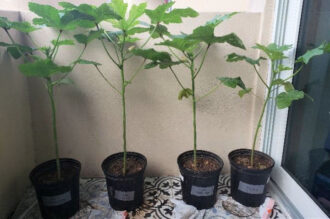MIAMI, Florida – Algal blooms, which can grow excessively on lakes and other slow-flowing bodies of water, are an environmental, ecological, economic, and social problem. But Florida International University (FIU) researchers are seeking to reverse those issues by using the microscopic organisms as biofertilizer in agricultural crops.
Agroecologist Krish Jayachandran and Earth and Environment post doctorate associate Saoli Chanda, along with Texas A&M University - Kingsville soil scientist Sanku Dattamudi, have received a three-year Southern Sustainable Agriculture Research and Education (SSARE) grant to collect algal blooms (generally made up of cyanobacteria) from Lake Okeechobee, drying the slurry, and applying the powder to tomato and okra crops. The goal is to determine if the cyanobacteria biofertilizer provides just as much, if not more, nutrients for the crops as commercial fertilizer, while also improving soil health.
“Cyanobacteria biofertilizer provides macro and micro-nutrients in the soil and improves nutritional properties of vegetables. Cyanobacteria also increase soil organic carbon accumulation, improve soil structure and biodiversity, enhance soil enzymatic activities, and protect plants from pathogens,” said Jayachandran. “We estimate that cyanobacteria biofertilizer would reduce 40 percent fertilizer cost than synthetic fertilizers for vegetable producers. Nutrients in cyanobacteria biofertilizer are in organic form and would be released slowly as the materials decompose. This process is similar to commercially available slow-release fertilizers that have become standard practice in reducing nutrient leaching and water quality protection.”

The researchers are collaborating with AECOM Technology Corporation in collecting cyanobacteria from the lake in 5-gallon buckets using a ‘float it up and skim it off’ micro-flotation technique, spreading the slurry on large plastic trays to dry and then grinding the dry material into powder form and storing it in plastic bags for application.
In one of the project objectives, researchers are applying the powder to tomato and okra plants in a greenhouse study to evaluate the effect of cyanobacteria biofertilizer on crop growth and soil properties. Preliminary results found that tomato production with cyanobacteria was similar to chicken manure, six times higher than the control of no fertilizer applied, and just as productive compared to synthetic fertilizer applications.
“Cyanobacteria biofertilizer has synergistic effects on tomato and okra production. Plants treated with cyanobacteria biofertilizer produced flowers and fruits earlier than other organic or synthetic nutrient sources used in the experiment. Therefore, the use of cyanobacteria biofertilizer enables growers early crop harvesting and securing of premium market price,” said Chanda.
The researchers plan to take their results to field settings at a later date in the project.
“Our nitrogen test for cyanobacteria biofertilizer falls within the range of about 2 percent, which is similar to poultry manure,” said Dattamudi. “The iron content of the cyanobacteria fertilizer is amazing, about 2,000 parts per million, which is great for Florida sandy soils, which generally lack iron because of low deficiency. Cyanobacteria fertilizer could serve as an excellent source of iron, as well as other micronutrients.”
FIU economist Mahadev Bhat hopes that with the evaluation of the nutritional properties of cyanobacteria and the results of the greenhouse and field studies, an assessment of the economic benefits of the biofertilizer application for vegetable production can be developed.
“No economic analysis of incorporating cyanobacteria on the farm as a biofertilizer is available. But we hope that based on the results of this study we can develop economic models relevant to both small producers and large farms for using cyanobacteria as a biofertilizer as a solution to removing and discarding the microorganisms from water sources in southern Florida,” said Bhat.
FIU aquatic biogeochemist Leonard Scinto is also involved in the research project.
